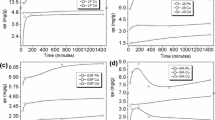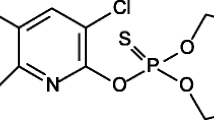Abstract
Chlorobenzoic acids represent crucial recalcitrant metabolites in the environment; thus, the influence of soil components on the sorption of 2,4,6-trichlorobenzoic acid (TCB) under oxic and anoxic conditions was studied. The surficial physiognomies of untreated and isolated soil samples were studied using FTIR, XRD, specific surface area, and PZC determination. The roles of redox potential, dissolved organic carbon (DOC), and pH, particularly under anoxic condition, were appraised. Batch equilibrium adsorption studies on soils of variable Fe/Mn oxides and organic carbon showed that adsorption was low across all components (log K oc = 0.82–3.10 Lg−1). The sorption of 2,4,6-TCB was well described by the pseudo second-order kinetic model. The fluctuation of both redox potential and pH during anoxic experiment had a negative impact on the sorption, partitioning, and the oxidation of organic matter. Linear relationships were observed for K d with both soil total organic carbon (TOC) and surface area (SA). The results showed the existence of DOC-mediated sorption of 2,4,6-TCB which seems to be enhanced at lower pH. The reductive dissolution, particularly of iron compounds, possibly impeded sorption of 2,4,6-TCB under anoxic condition. It could be inferred that habitats dominated by fluctuating oxygen concentrations are best suited for the development of environmental conditions capable of mineralizing 2,4,6-TCB and similar xenobiotics.







Similar content being viewed by others
References
Avena, M. J., & Koopal, L. K. (1998). Desorption of humic acids from an iron oxide surface. Environmental Science & Technology, 32, 2572–2577.
Bedard, D. L. (2003). Polychlorinated biphenyls in aquatic sediments: Environmental fate and outlook for biological treatment. In M. M. Häggblom & I. Bossert (Eds.), Dehalogenation: Microbial processes and environmental applications (pp. 443–465). Boston: Kluwer Press.
Blanachard, G., Maunaye, M., & Martin, G. (1984). Removal of heavy metals from watersby means of natural zeolites. Water Research, 18, 1501–1507.
Callao, P. (2007). Kinetic and adsorption study of acid dye removal using activated carbon. Chemosphere, 69, 1151–1158.
Chao, T. T. (1984). Use of partial dissolution techniques in geochemical exploration. Journal of Geochemical Explosives, 20, 101–135.
Chiou, C. T., Malcolm, R. L., Brinton, T. I., & Kile, D. E. (1986). Water solubility enhancementof some organic pollutants and pesticides by dissolved humic and fulvicacids. Environmental Science & Technology, 20, 502–508.
Chiou, C. T., Kile, D. E., Brinton, T. I., Malcolm, R. L., Leenheer, J. A., & McCarthy, P. A. (1987). Comparison of water solubility enhancements of organic solutes by aquatic humic materials and commercial humic acids. Environmental Science & Technology, 21, 1231–1234.
DiGeronimo, M. I., Nikaido, M., & Alexander, M. (1979). Utilization of chlorobenzoates by microbial populations in sewage. Applied and Environmental Microbiology, 37, 619–625.
Dolfing, J., & Tiedje, J. M. (1991). Innuence of substituents on reductive dehalogenation of 3-chlorobenzoate analogs. Applied and Environmental Microbiology, 57, 820–824.
Field, J. A., & Sierra-Alvarez, R. (2008). Microbial transformation of chlorinated benzoates. Reviews in Environmental Science and Biotechnology, 7, 191–210.
Freundlich, H. M. F. (1906). Über die adsorption in lösungen. Zeitschrift für Physikalische Chemie, 57A, 385–470.
Gauthier, T. D., Seitz, W. R., & Grant, C. L. (1987). Effect of structural and compositional variations of dissolved humic materials on pyrene K0C values”. Environmental Science & Technology, 21, 243–248.
Gerritse, J., & Gottschal, J. C. (1992). Mineralization of the herbicide 2,3,6-trichlorobenzoic acid by a co-culture of anaerobic and aerobic bacteria. FEMS Microbiology Ecology, 101, 89–98.
Gichner, T., Lovecka, P., & Vrchotova, B. (2008). Genomic damage induced in tobacco plants by chlorobenzoic acids—metabolic products of polychlorinated biphenyls. Mutation Research, 657, 140–145.
Gotoh, S., & Patrick, W. H. (1974). Transformation of iron in a waterlogged soil as influenced by redox potential and pH. Soil Science Society of America Journal, 38, 66–71.
Gruau, G., Dia, A., Olivie-Lauqueta, G., Davranche, M., & Pinay, G. (2004). Controls on the distribution of rare earth elements in shallow groundwaters. Water Research, 38, 3576–3586.
Hang, P. T. (1970). Methylene blue absorption by clay minerals—determination of surface areas and cation exchange capacities. Clays and Clay Minerals, 18, 203–212.
Horowitz, A., Sunita, J. M., & Tiedje, J. M. (1983). Reductive dehalogenations of halobenzoates by anaerobic lake sediment microorganisms. Applied and Environmental Microbiology, 45, 1459–1465.
Hunchak-Kariouk, K., Schweitzer, L., & Suffet, I. H. (1997). Partitioning of 2,2,4,4_-tetrachlorobiphenyl by the dissolved organic matter in oxic and anoxic pore waters. Environmental Science & Technology, 31, 639–645.
Kaiser, K., & Guggenberger, G. (2003). Mineral surfaces and soil organic matter. European Journal of Soil Science, 54, 219–236.
Kaiser, K., & Zech, W. (1999). Release of natural organic matter sorbed to oxides and a subsoil. Soil Science Society of America Journal, 63, 1157–1166.
Langmuir, L. (1918). The adsorption of gases on plane surfaces of glass, mica and platinum. Journal of the American Chemical Society, 40, 1361–1403.
Largegren, S. (1898). About the theory of so-called adsorption of soluble substances. KungligaSuensk Vetenskapsakademiens Handlingar, 24, 1–39.
Lee, P. Y., & Chen, C. Y. (2009). Toxicity and quantitative structure–activity relationships of benzoic acids to Pseudokirchneriellasubcapitata. Journal of Hazardous Materials, 165, 156–161.
Li, F. M., Wang, X. L., Li, Y., Guo, S. H., & Zhong, A. P. (2006). Selective extraction and separation of Fe, Mn oxides and organic materials in river surficial sediments. Journal of Environmental Sciences-China, 18(6), 1233–1240.
Lima, E. C., Royer, B., Vaghetti, J. C. P., Brasil, J. L., Simon, N. M., dos Santos, A. A., Jr., Pavan, F. A., Dias, S. L. P., Benvenutti, E. V., & da Silva, E. A. (2007). Adsorption of Cu (II) on Araucaria angustifolia wastes: determination of the optimal conditions bystatistic design of experiments. Journal of Hazardous Materials, 140, 211–220.
Mac Rae, L. C., & Alexander, M. (1965). Microbial degradation of selected herbicides in soil. Journal of Agricultural and Food Chemistry, 13, 72–76.
Matson, C., Palatnikov, G., Islamzadeh, A., McDonald, T., Autenrieth, R., Donnelly, K., & Bickham, J. (2005). Chromosomal damage in two species of aquatic turtles (Emys orbicularis and Mauremyscaspica) inhabiting contaminated sites in Azerbaijan. Ecotoxicology, 14, 513–525.
Matson, C. W., Lambert, M. M., McDonald, T. J., Autenrieth, R. L., Kirby, C. D., Islamzadeh, A., Politov, D. I., & Bickham, J. W. (2006). Evolutionary toxicology: population-level effects of chronic contaminant exposure on the marsh frogs (Ranaridibunda) of Azerbaijan. Environmental Health Perspectives, 114, 547–552.
Mikutta, R., Kleber, M., Kaiser, K., & Jahn, R. (2005). Review: organic matter removal from soils using hydrogen peroxide, sodium hypochlorite, and disodium peroxodisulfate. Soil Science Society of America Journal, 69(1), 120–135.
Olivie-Lauquet, G., Gruau, G., Dia, A., Riou, C., Jaffrezic, A., & Henin, O. (2001). Release of trace elements in wetlands: role of seasonal variability. Water Research, 35, 943–952.
Ololade, I. A., Oladoja, N. A., Oloye, F. F., Alomaja, F., Akerele, D. D., Iwaye, J., & Aikpokpodion, P. (2014). Sorption of glyphosate on soil components: the roles of metal oxides and organic materials. Soil and Sediment Contamination: An International Journal, 23, 571–585.
Pedersen, J. A., Gabelich, C. J., Lin, C., & Suffet, I. H. (1999). Aeration effects on the partitioning of a PCB to anoxic sediment pore water dissolved organic matter. Environmental Science & Technology, 33, 1388–1397.
Pedersen, H. D., Postma, D., Jakobsen, R., & Larsen, O. (2005). Fast transformation of iron oxyhydroxides by the catalytic action of aqueous Fe(II). Geochimica EtCosmochimica Acta, 69, 3967–3977.
Pei, Z. G., Shan, X. Q., Wen, B., Zhang, S. Z., Yan, L. G., & Khan, S. U. (2006). Effect of copper on the adsorption of p-nitrophenol onto soils. Environmental Pollution, 139(3), 541–549.
Pickering, E. W., & Veneman, P. L. M. (1984). Moisture regimes and morphological characteristics in a hydrosequence in central Massachusetts. Soil Science Society of America Journal, 48, 113–118.
Reuter, R. J., & Bell, J. C. (2001). Soils and hydrology of a wet sandy Catena in East Central Minnesota. Soil Science Society of America Journal, 65, 1559–1569.
Sahm, H., Brunner, M., & Schobert, S. M. (1986). Anaerobic degradation of halogenated aromatic compounds. Microbial Ecology, 12, 147–153.
Seunghum, H., & Linda, S. L. (2004). Hydrophilic and hydrophobic adsorption of organic acids by variable-change soils: effect of chemical acidity and acidic functional group. Environmental Science & Technology, 38, 5413–5419.
Sorensen, S. R., Holtze, M. S., Simonsen, A., & Aamand, J. (2007). Degradation and mineralization of nanomolar concentrations of the herbicide dichlobenil and its persistent metabolite 2,6-dichlorobenzamide by Aminobacter spp. isolated from dichlobenil-treated soils. Applied Environmental Microbiology, 73, 399–406.
Swartz, C. D., Donnelly, K. C., Islamzadeh, A., Rowe, G. T., Rogers, W. J., Palatnikov, G. M., Mekhtiev, A. A., Kasimov, R., McDonald, T. J., Wickliffe, J. K., Presley, B. J., & Bickham, J. W. (2003). Chemical contaminants and their effects in fish and wildlife from the industrial zone of Sumgayit, Republic of Azerbaijan. Ecotoxicology, 12, 509–521.
Tao, Q. H., Wang, D. S., & Tang, H. X. (2006). Effect of surfactants at low concentrations on the sorption of atrazine by natural sediment. Water Environment Research, 78(7), 653–660.
Tessier, A., Campbell, P. G. C., & Bisson, M. (1979). Sequential extraction procedure for the speciation of particulate trace-metals. Analytical Chemistry, 51(7), 844–851.
Vijayaraghavan, K., Palanivelu, K., & Velan, M. (2006). Biosorption of copper (II) and cobalt(II) from aqueous solutions by crab shell particles. Bioresearch Technology, 97, 1411–1419.
Wahid, P. A., & Sethunathan, N. (1979). Sorption–desorption of α, β and γ isomers of hexachlorocyclohexane in soils. Journal of Agricultural and Food Chemistry, 27, 1050–1053.
Walker, G. M., & Weatherley, L. R. (1999). Kinetics of acid dye adsorption on GAC. Water Research, 33, 1895–1899.
Yu, K. C., Tsai, L. J., Chen, S. H., & Ho, S. T. (2001). Chemical binding of heavy metals in anoxic river sediments. Water Research, 35(17), 4086–4094.
Zhao, Y. H., Ji, G. D., Cronin, M. T. D., & Dearden, J. C. (1998). QSAR study of the toxicity of benzoic acids to Vibrio fischeri, daphnia magna and carp. Science of Total Environment, 216, 205–215.
Acknowledgments
This research was funded by the Adekunle Ajasin University Akungba Akoko (Nigeria) Tertiary Education Trust Fund (TETFUND 2013/2014). Special thanks to Assistant Professor Ifedayo Victor Ogungbe of the Department of Chemistry and Biochemistry, Jackson State University, USA, for valuable contributions.
Author information
Authors and Affiliations
Corresponding author
Rights and permissions
About this article
Cite this article
Ololade, I.A., Oladoja, N.A., Alomaja, F. et al. Influence of organic carbon and metal oxide phases on sorption of 2,4,6-trichlorobenzoic acid under oxic and anoxic conditions. Environ Monit Assess 187, 4170 (2015). https://doi.org/10.1007/s10661-014-4170-2
Received:
Accepted:
Published:
DOI: https://doi.org/10.1007/s10661-014-4170-2




